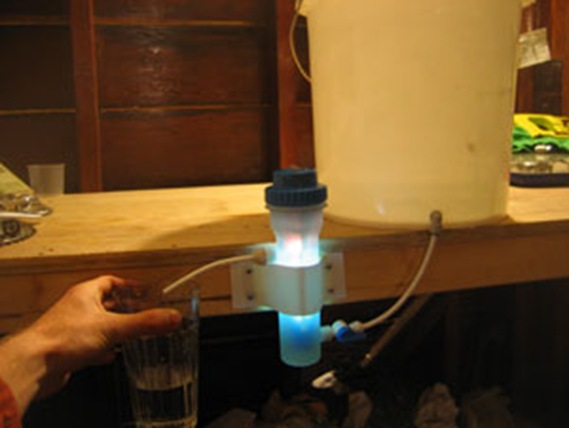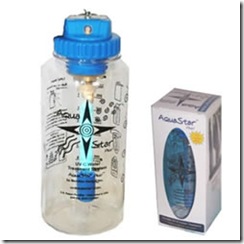UV-C light purification
AquaStar was designed to be sold to a high-end market to fund a lower-cost application in the developing world. The more expensive AquaStar Plus! is used in the harshest environments by travelers, military personnel, and rescue workers. Unsafe water is placed in the bottle and exposed to UV-C light, which damages the DNA and RNA in the pathogens, rendering them non-infective. AquaStar Flow Through treats water in larger batches. A small water-purification service can generate income while helping out the community.
The AquaStar™ UV Portable Water Purifier is a spectracidal treatment solution appropriate for use in all climates and settings. Campers, hikers, emergency crews, and families who depend on having clean water, depend on Aquastar.
Using a pair of standard camera batteries, the AquaStar™ UV Portable Water Purifier can safely and quickly treat a liter of water in about a minute. Lightweight — less than 4 ounces (106 grams), rugged and simple one-button operatation, everyone should have an AquaStar™ UV Portable Water Purifier packed in their survival kit.
Anyone who has spent time in the backcountry has likely used a portable water filter. Anyone who hasn’t and caught an intestinal parasite likely does now. There are many waterborne threats, which manage to kill over 3,000,000 people worldwide and seriously sicken hundreds of millions. These disease vectors fall into three main categories: 
1. Protozoa, such as Giardia, Entamoebic Dysentery, and Cryptosporidium
2. Bacteria, such as Cholera, Shigella (dysentery), E. Coli, Salmonella, Trachoma
3. Viruses, such as Hepatitis, Rotavirus, Norovirus, Enterovirus (meningitis) 
Listed above are the major culprits responsible for waterborne illness. Some, such as Rotavirus, kill over ½ million people per year while others are merely debilitating, like Trachoma, which causes blindness. 
Although bacteria and viruses cause most waterborne diseases worldwide, the average hiker in a first world environment is likely to be felled by a protist. There are obvious exceptions: The recent spate of cruise-ship diarrhea outbreaks were caused by Noroviruses. In Mexico, what is referred to as Montezuma’s revenge is a Rotavirus. E. Coli has garnered quite a bit of press for those areas afflicted with livestock runoff, and so on.
Give these nasties a lethal suntan — try clean water with an AquaStar™ UV Water Purifier.
The major complaint usually leveled against water filters is simple inconvenience. Who wants to have to squat uncomfortably next to a stream for a half hour and exhaust their arm muscles pumping a gallon of water and do this several times a day during a hike? Also, a filter takes up space and weighs a pound or more with the filter cartridge wet (and let’s face it, that’s how it gets carried around).
 Pump filters often have many loose parts to keep track of: hoses, cartridges, levers and more. The plastic case can be fragile — especially in cold weather when the plastic is brittle — and, if manhandled or dropped, will crack, leaving you with a useless, heavy souvenir from your camping trip. This is especially true for those popular units, which have a plastic weld line along the side of the plunger where it is prone to cracking.
Pump filters often have many loose parts to keep track of: hoses, cartridges, levers and more. The plastic case can be fragile — especially in cold weather when the plastic is brittle — and, if manhandled or dropped, will crack, leaving you with a useless, heavy souvenir from your camping trip. This is especially true for those popular units, which have a plastic weld line along the side of the plunger where it is prone to cracking.
 Almost no one does it, but to prevent mold and mildew, the filter on the pump should be rinsed in dilute chlorine solution and dried after each trip. Micro-pore water filters are very good at protecting against protists, fair against bacteria and poor against viruses. The more expensive, and heavier, ceramic based filters do screen well for bacteria but still let viruses through. Some filters attempt to compensate with chemical impregnation of the filter element with iodine.
Almost no one does it, but to prevent mold and mildew, the filter on the pump should be rinsed in dilute chlorine solution and dried after each trip. Micro-pore water filters are very good at protecting against protists, fair against bacteria and poor against viruses. The more expensive, and heavier, ceramic based filters do screen well for bacteria but still let viruses through. Some filters attempt to compensate with chemical impregnation of the filter element with iodine.
 However, iodine takes time to work against pathogens and water is not long in a filter. Thus with iodine tablets, the recommended exposure time is ½ hr up to 4hrs if the water is cold which inhibits the antibiotic activity. Even the newer "mixed oxidant" (MIOX) portable systems still require several hours to be effective, depending on the electrolytic conversion of salt to a form of pool chlorine that might kill most, but not all, the pathogens in the treated water.
However, iodine takes time to work against pathogens and water is not long in a filter. Thus with iodine tablets, the recommended exposure time is ½ hr up to 4hrs if the water is cold which inhibits the antibiotic activity. Even the newer "mixed oxidant" (MIOX) portable systems still require several hours to be effective, depending on the electrolytic conversion of salt to a form of pool chlorine that might kill most, but not all, the pathogens in the treated water.
The increasing pollution of the environment by inorganic and organic substances has helped ultra-violet (UV) disinfection gain increased acceptance as a part of consumer water treatment systems. Most high-end home water filter systems now employ UV components, and a variety of products from Sharper Image, General Electric and Panasonic are UV-based quality appliances. 
The UV disinfection process itself is simple, reliable and economical, yet most UV water purification systems still add one or more carbon or mesh filters to improve taste and odor of the water. These systems, while effective, generally require high water pressure, standard household electric current, and bulky components and tubing. Because of the complexity of these systems, it is difficult to keep the cost down.
 But in many settings outside of the home, a full-blown water filtration isn’t needed. Instead, the primary need in a camper or survivalist is to purify the water. This is where UV is ideal. Ultra-violet C-band (UV-C) purifiers work differently from filtration systems by generating ionizing radiation at 254nm that quickly and effectively disrupts the cellular chemistry of all known pathogens, halting DNA replication, and breaking down organic components of alien living organisms into harmless material.
But in many settings outside of the home, a full-blown water filtration isn’t needed. Instead, the primary need in a camper or survivalist is to purify the water. This is where UV is ideal. Ultra-violet C-band (UV-C) purifiers work differently from filtration systems by generating ionizing radiation at 254nm that quickly and effectively disrupts the cellular chemistry of all known pathogens, halting DNA replication, and breaking down organic components of alien living organisms into harmless material.
The AquaStar™ Ultraviolet (UV-C) Water Purifier directly addresses the five major challenges of making a portable UV-C germicidal water system: (1) Size, (2) Weight, (3) Cost, (4) Durability, and (5) Complexity.
(1) Our UV-C purifier takes up virtually no additional room in your gear or survival kit since it fits inside the same type of standard 1L wide-mouth water bottle that most people pack. How do we do it? We replace the cap on the bottle with a low-profile weather-sealed electronics package. And we also supply a quality polycarbonate bottle with our purifier, just in case you don’t have one already; but you can certainly use your own favorite bottle if you prefer.
(2) AquaStar™ adds only 3 ounces of weight (about 50 grams) — including batteries — to the weight of the water bottle it is mounted on. Both HDPE and polycarbonate Nalgene®-style wide-mouth bottles are already very light, so for the ultralight hikers, AquaStar™ is definitely the way to go. In addition, the AquaStar™ is designed to use small, lightweight CR-123 batteries, the same type used in pocket-sized point-and-shoot cameras.
(3) By making the AquaStar™ out of commonly available components, the cost is kept low. And, by keeping the parts count to a minimum, and avoiding wasteful display packaging, we drive the cost down even lower. But low cost doesn’t mean low quality! Each component is still the best in its class. From the odor-free polycarbonate bottle to the Philips Sterilamp® UV-C tube — rated at 8,000 hours of use — AquaStar™ is designed for years of trouble-free operation.
(4) The AquaStar™ is designed for the sports enthusiast. We know what kinds of crazy environments you seem to end up in because we’ve been there! Jungles, deserts, glaciers, flood zones, hurricanes, caving and volcano watching — whatever your scenery, you can count on AquaStar™. The resilient quartz UV-C tube is shock-mounted at both ends in the bottle. The electronics head is completely sealed against water, sand, and gases. There are no moving parts to snap off or bend. Of course, the AquaStar™ Ultraviolet (UV-C) Water Purifier is also right at home in your earthquake or disaster preparedness kit, or in a roadside emergency kit in the trunk of your car.
(5) Purifying water is a serious business. You want to trust the product your health depends on. The intelligent brain of the AquaStar™ Ultraviolet (UV-C) Water Purifier is a programmable microcontroller that keeps track of the sterilization process for you. AquaStar™ meters the correct dosage per liter of 254 nm radiation for safe drinking water. All you have to do is push one button and wait a minute for the green light. That’s it. Simple. The way things should be.
We think we’ve designed a terrific product that will meet the needs of almost anyone. We hope you agree!









